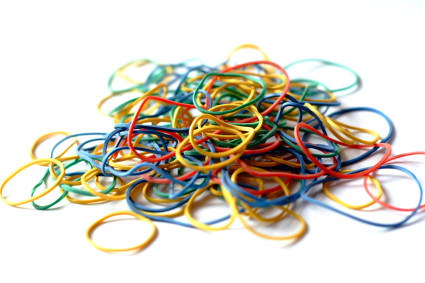A Lesson in Potential and Kinetic Energy
- June 20, 2014
- By Marjorie Frank
 Almost every day, mail bundled with a rubber band arrives through my door slot. Plus, bunches of parsley, broccoli, and a myriad of other vegetables, also held together with rubber bands, are constants in my kitchen. By the end of a week, it’s not unusual to find myself with an additional dozen stretchy bands hiding in drawers, suspended on knobs, or encircling open packages of flour, grains, and sugar.
Almost every day, mail bundled with a rubber band arrives through my door slot. Plus, bunches of parsley, broccoli, and a myriad of other vegetables, also held together with rubber bands, are constants in my kitchen. By the end of a week, it’s not unusual to find myself with an additional dozen stretchy bands hiding in drawers, suspended on knobs, or encircling open packages of flour, grains, and sugar.
What to do. All these rubber bands are perfectly serviceable, so it seems a shame to discard them. On the other hand, how many rubber bands can a person use? And who wants them hanging around long enough to degrade and snap at the very moment you put them to use?
One day the answer came to me, and I’ve felt good about collecting rubber bands ever since: I could re-purpose them in the interest of rubber band science.
A quick trip to the Internet yielded a plethora of activities involving rubber bands. Here are some of the most interesting ones I found.
Potential and Kinetic Energy
How are potential and kinetic energy connected? To find out, you’ll need open space; a piece of chalk; and a measuring tape, and a rubber band and a ruler for each pair of students. Draw a chalk line on the floor and have pairs of students stand arms’ length apart with their toes on the line. For safety, no one should step in front of the line until you say so.
Ask one member of each pair to hook the rubber band onto the edge of the ruler, pull it back to a designated length, (i.e. 4 inches, 5 inches etc.) and release it straight ahead when you say to do so. Have the partner mark the place where the rubber band lands and measure the distance from that place to the chalk line. Note the distance in a data table such as the following:
| Distance | 4 in. | 5 in. | 6 in. | 7 in. |
| Trial #1 | ||||
| Trial #2 | ||||
| Trial #3 | ||||
| Trial #4 | ||||
| Trial #5 |
Repeat the process four more times. Were the results consistent? If not, average the data. Then stretch the rubber band an additional inch and repeat the procedure. Graph and analyze the results. What pattern do you observe? What can you and your students say about the relationship between the amount of stretch (potential energy) and the distance the rubber band traveled (kinetic energy)? What’s the connection? To explore further, repeat the activity with rubber bands of different sizes and widths. How does each variable affect the outcome?
(For a more detailed description of the activity, go to http://www.sciencebuddies.org/science-fair-projects/project_ideas/ApMech_p017.shtml#procedure)
Rubber Bands and Heat
Most matter expands when heated. That’s why popcorn pops and balloons rise when the air in side them is warmed. Rubber bands, however, have an interesting an unexpected response to heat.
An exploration can begin with a thick rubber band. Hold the ends and pull the rubber band taut, but don’t stretch it. Then touch the rubber band to your face; pay attention to how warm or cool it feels. (The area just above the upper lip is especially sensitive to temperature.) Next, quickly pull the rubber band to stretch it. While it’s still stretched, touch the rubber band to your face. Has the temperature changed? Finally, hold the rubber band away from your face, but keep it stretched. After about 15 seconds, let the rubber band go slack, but don’t let it go. Touch it to your face once more. How has the temperature changed?
For a clear explanation of the results and an outrageously counterintuitive ancillary activity, follow this link: http://www.scientificamerican.com/article/bring-science-home-rubber-band-heat/ .
The Power of….Soap? Water? Rubber Bands?
The only materials you’ll need for this investigation are named in the title, plus a bowl to hold the water. First, place a rubber band on a table and have students describe its shape. Then gently place the band in a bowl of water. Students should observe that the shape stays pretty much the same. Now, place a sliver of soap in the center of the rubber band. Boom! The rubber band snaps into the shape of a circle. How does that work?? Does soap have the power to push the rubber band out? Check out an easy-to-follow explanation here: http://science-notebook.com/liquids02.html#Weakening_Surface_Tension_With_Soap.
Rubber Band Observations
You can help sharpen your students’ powers of observation with this simple activity. All you need is a fat rubber band and a straightened paper clip. When you roll up the rubber band from one end, you’ll see that it has two loops in the center. One of these loops is inside the rubber band; the other is outside. Invite a student to observe the rolled up rubber band closely and then put a paper clip through the hole that is on the inside. If the student chooses correctly, the rubber band will hang from the wire. If not, it will fall. Allow pairs of students to take turns trying to find the inside of the rubber band.
Unless their observations are extremely keen, they’re likely to miss as often as they succeed. Invite anyone who has figured out how to succeed every time to tell the “secret.” If not, suggest they count the layers of rubber band outward from each loop. (The loop at the center of an odd number of layers is inside the rubber band.)
These are only a few of the many rubber band activities on the Web. At last, a way to re-purpose all those rubber bands hanging around and help kids connect with science!


